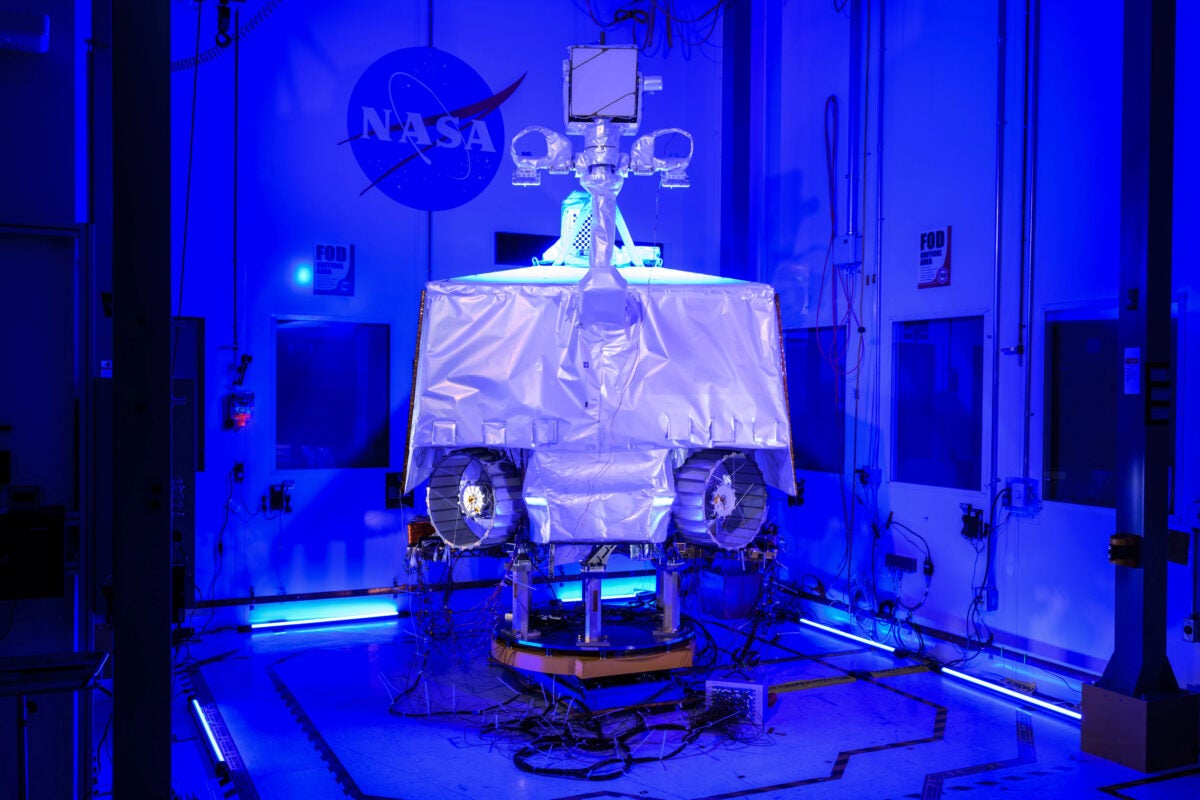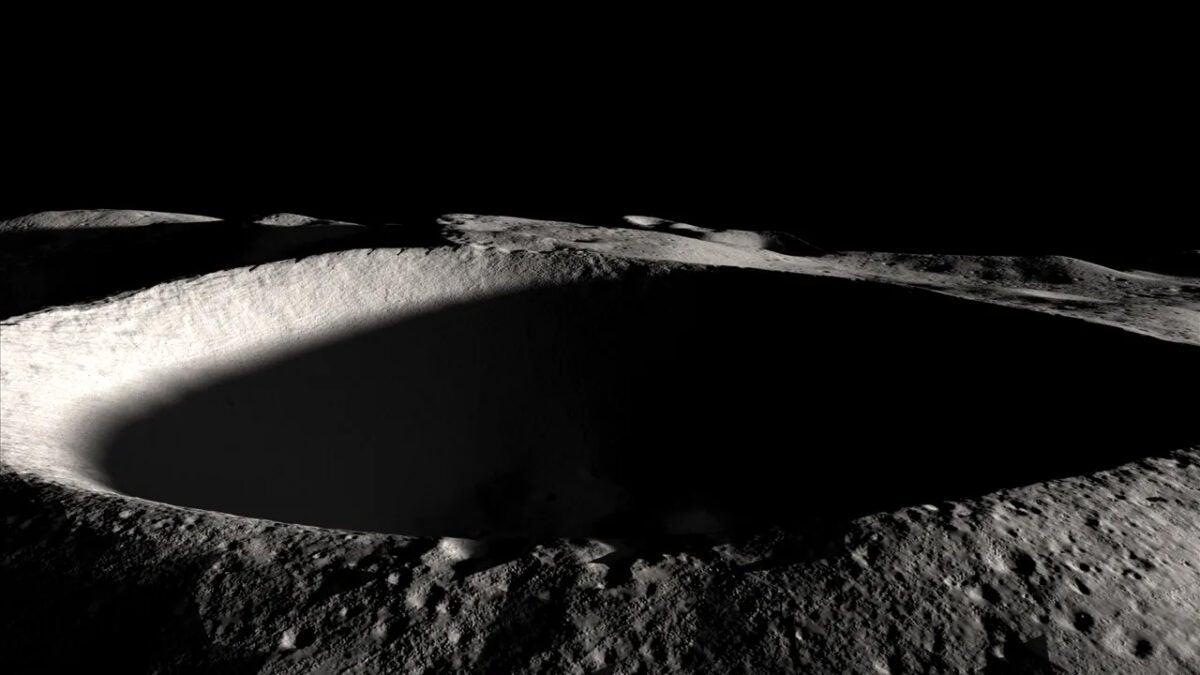
The VIPER, equipped with headlights, would have been the first robotic lunar rover capable of operating at night. Credit: NASA
To the surprise of the lunar scientific community, on July 17, NASA… cancelled the long-awaited VIPER (Volatiles Investigating Polar Exploration Rover) mission, which was expected to search for water ice on the Moon, a critical resource for future explorers.
VIPER was one of the highest-profile missions in NASA’s Commercial Lunar Payload Services (CLPS) program, which is sending robotic missions to the Moon in support of future Artemis crews. Artemis aims to land near the lunar south pole, where the Sun’s shallow angle means many craters are in permanent shadow. Scientists know these craters contain water ice, which could be used as drinking water for astronauts and as a resource for rocket fuel and power production. But we don’t know how much ice is there, or how easy it will be to mine. VIPER’s mission was to answer those questions, and its cancellation deprives the Artemis program of critical data.
Equally shocking to the scientific community is that $450 million has already been spent on the design and construction of VIPER and its instrument suite. The finished VIPER only needed to pass its environmental tests, to ensure it could survive the incredibly harsh and perpetually shadowed polar regions of the Moon. The Astrobiotics Griffin rover and lunar lander that would deposit VIPER near the south pole were scheduled to launch in September 2025, aboard a SpaceX Falcon Heavy rocket.
NASA has said it is willing to hand VIPER over to another organization to take it to the Moon, provided there is no additional cost to NASA. If no takers emerge, current plans call for VIPER to be dismantled and its instruments scrapped for possible use on future missions.
The cost of cost cutting

NASA says the cancellation of VIPER is because COVID-19-induced supply chain issues with both the rover and its Griffin lander have increased the mission's costs and delayed its planned launch by two years. By canceling the project, after having already spent nearly $500 million, NASA says it will save $84 million. At the same time, NASA will pay Astrobiotics $323 million to complete the Griffin lander and take it to the Moon without VIPER. Right now, plans call for landing a “mass simulator,” or dead weight, that will return no scientific data about the Moon.
An even deeper concern is that VIPER’s cancellation could be the tip of the iceberg for NASA’s ambitious, but chronically underfunded, lunar exploration programs. VIPER’s demise is a hint that more bad news may be coming, not only with the CLPS robotic programs but also with the crewed return of Artemis to the Moon. The landing of a dead-weight Griffin lander that returns no lunar science data certainly won’t help NASA’s funding woes.
In addition to the vast amount of data on ice and volatile compounds that won’t be collected, the cancellation is a public relations blow for NASA at a time when the agency needs public support. VIPER may not have received the same level of attention as flagship missions like Mars Sample Return or the James Webb Space Telescope, but videos of the rover deftly maneuvering through testing terrain continued to circulate on news channels even several days after the program’s cancellation was announced.
VIPER Capabilities
If VIPER were to have the chance to carry out its mission, it would boast a number of features designed to explore the icy, shadowed polar craters. With a square shape measuring 1.5 meters on a side and 2.4 meters high, the vehicle would be the first on the Moon equipped with headlights for operation at night. VIPER also features an innovative wheel design, with independent steering and active suspension for all four wheels. This would allow the rover to traverse a variety of ground conditions on the Moon, ranging from compact, beach-like sand to soft, fluffy dust that would bring a more conventional vehicle to a halt. To traverse especially soft ground, VIPER’s wheels can be independently raised and moved back and forth, propelling VIPER forward in a swimming motion.

VIPER’s primary goals were to study ice and volatile compounds in permanently shadowed polar craters so that scientists could evaluate their usefulness for future crews. In addition to identifying useful volatile compounds such as hydrogen, ammonia, and carbon dioxide, VIPER was to search for volatile compounds that could be detrimental to Artemis missions. To accomplish this, VIPER would have used a suite of spectrometers and a drill capable of penetrating the surface to a depth of 40 inches (1.0 m) to extract subsurface samples for analysis.
The New Territory Ice and Regolith Drill (TRIDENT), developed by Honeybee Robotics, is a carbide-tipped percussion drill equipped with a temperature sensor at its tip. The drill would extract drill chips that would be deposited in a chute for analysis by three spectrometers: the Neutron Spectrometer System (NSS), the Near-Infrared Volatiles Spectrometer System (NIRVSS), and the Lunar Operations Observation Mass Spectrometer (MSolo).
Related: Scientists suspect ice is hidden on the Moon
Mission planning called for VIPER to operate for 100 days on the lunar surface. Controlled by a driver on Earth, the rover would be commanded to move in 15-foot (4.6 m) increments between science operations. The rover would normally have traversed terrain up to 15 degrees incline, but could have maneuvered on a 30-degree slope if necessary. VIPER's top speed would have been 0.45 mph (0.73 km/h), or about 9 inches (23 centimeters) per second. This frenetic pace would be slowed to 2 to 4 inches (5 to 10 cm) per second during science operations, when spectrometers would scan the surface for potential ice targets for the TRIDENT drill.
The Moon’s natural libration, or monthly cyclic roll and pitch as seen from Earth, would periodically take the rover out of contact with mission controllers. Mission planning called for planned two-week cruises to explore for water, and the rover would arrive at a predetermined location to await reestablishment of line-of-sight communications with Earth. Since the Sun never rises more than 10° above the horizon at VIPER’s landing site, the rover would have to be carefully positioned to ensure sunlight could reach its solar panels to recharge its batteries; VIPER can only survive 50 hours of continuous darkness.
VIPER's Plan B
As exciting as VIPER’s lunar ice data have been, all is not lost so far. The Polar Ice and Resources Mining Experiment-1 (PRIME-1) mission is scheduled to launch on a SpaceX Falcon 9 later this year and will also search for ice in the polar regions. PRIME-1 will carry identical copies of the TRIDENT lunar drill and MSolo spectrometer that were to operate on VIPER. However, these instruments will remain attached to the PRIME-1 lander and will not be able to investigate large areas as planned with the VIPER rover, significantly reducing its science output.








Leave feedback about this